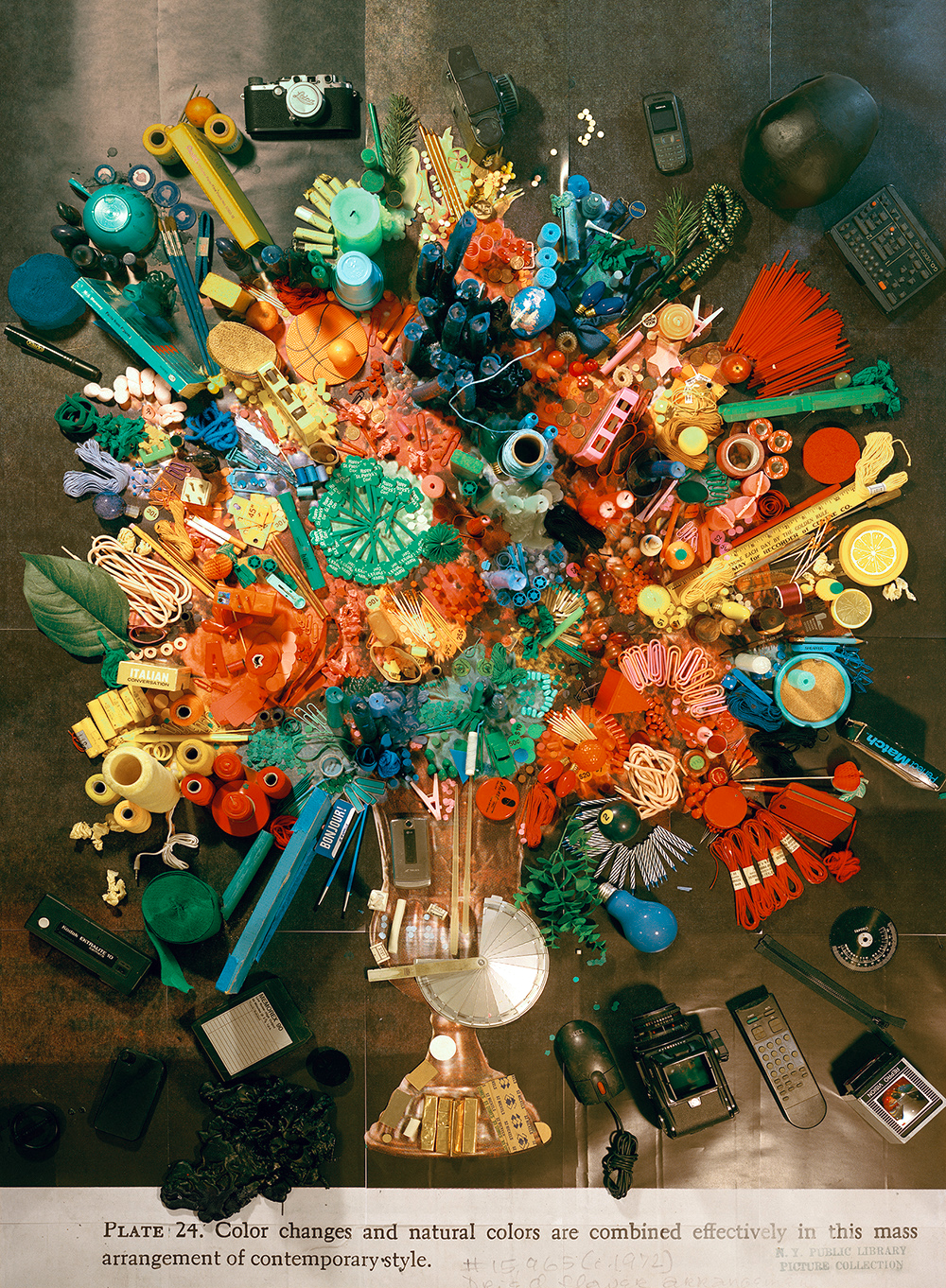Our Things Will Outlast Us: On Sara Cwynar and Permanence
By
Britt Gallpen
Posted on
April 11, 2016

Sara Cwynar, "Contemporary Floral Arrangement 2 (Plate 24. Color Changes and natural colors are combined effectively in this mass arrangement of contemporary style)" (2013). Chromogenic print. 152.4 cm x 111.76 cm. Courtesy of the artist and Cooper Cole Gallery
The Permanence of Things was originally published in the Walter Phillips Gallery exhibition catalogue for "things you can't unthink." More on the exhibition here.
They shimmied back and forth between debris and thing—between, on the one hand, stuff to ignore, except insofar as it betokened human activity […] and, on the other hand, stuff that commanded attention in its own right, as existents in excess of their association with human meanings, habits, or projects.
– Jane Bennett, Vibrant matter: A Political Ecology of Things
It is estimated that there are as many as 370,000 pieces of space junk currently orbiting our planet. Ranging upwards in size from a fleck of paint, this debris has accumulated at an accelerated pace since the dawn of the Space Race and is comprised of old rockets, abandoned satellites and other human-generated waste. A recent visualization produced by Dr. Stuart Grey of University College London, one that is simultaneously fascinating and horrifying, exposes the extent of this human impact on Earth’s atmosphere.[1] For all but a small number of us, this swarm of trash remains invisible, and most certainly, this mass of celestial stuff—this space junk—will outlast us.
So, too, will the plastic ephemera of Sara Cwynar’s pictures. The artist offers us glimpses into the durational life of objects: patinaed coins, unravelled threads, charred candlewicks. Each belie their beginnings and suggest their probable ends and in doing so, carry the traces of their interactions with human and non-human forces. Their productions and receptions of force and movement are mapped on their surfaces but also impressed as memory. These Things and their Thing-Power—in the sense of Jane Bennett’s uncanny other-ing of things, whereby ordinary things “exceed their status as objects […] to manifest traces of independence or aliveness”—signal the possibility of deep fissures between functionality and the lifespans of stuff.[2] What will they do and where will they go when we’re gone?
Wryly evoking the weighty genre of still life and the dark, lush floral compositions that were the subject of many 17th century Dutch painters, Cwynar’s “thing” bouquets are similarly created through intricate assemblage and arrangement. The artist pushes and pulls against photography, creating a ground with enlarged, digitally reproduced archival images rendered through a large format camera. The use of near obsolete technologies and a spectrum of waning and dated colours piercingly highlight the passage of time in much the same vein as the Dutch painters’ insects and butterflies signalled the inevitability of eventual decay. Using the studio floral arrangement as a guide, the artist reimagines organic matter through plastics, metals, papers and fibres. Constructing elaborate serialized components, these three-dimensional elements are piled, balanced and fanned before being flattened through the lens.
This technique, of fusing the organic (here representations of flowers) with the inorganic, is evocative of larger markers of the Anthropocene—the proposed time period wherein the effects of human activity upon the natural world have become irreversible—including the recent discovery of plastiglomerates, rocks infused with plastic off the coast of Hawaii’s Big Island, as well as the undeniable human impact on our atmosphere.[3] Despite the possible threat of extinction imposed upon humankind by our own destructive existence, our manufactured traces will endure. They speak to the dissolution of the discrete categories of the human-made and natural, from the space junk to the plastiglomerates: as above, so below.
Britt Gallpen is a writer and curator based in Toronto, and is the editor of Inuit Art Quarterly. This article was previously published in the catalogue for the Walter Phillips Gallery exhibition, "things you can’t unthink," and was titled "The Permanence of Things."
Endnotes
1 O’Hare, Ryan. “See Decades of Space Debris Swarm the Earth in 60 Seconds: Video Reveals How the Planet’s Orbit Has Become a ‘Junkyard’,” Daily Mail Online, December 31, 2015. http://www.dailymail.co.uk/sciencetech/article-3380183/See-decades-space-junk-swarm-Earth-60-seconds.... html#ixzz3wTVP9rEq. Accessed January 1, 2016.
1 O’Hare, Ryan. “See Decades of Space Debris Swarm the Earth in 60 Seconds: Video Reveals How the Planet’s Orbit Has Become a ‘Junkyard’,” Daily Mail Online, December 31, 2015. http://www.dailymail.co.uk/sciencetech/article-3380183/See-decades-space-junk-swarm-Earth-60-seconds.... html#ixzz3wTVP9rEq. Accessed January 1, 2016.
2 Bennett, Jane. 2009. Vibrant Matter: A Political Ecology of Things. Duke University Press: Durham. xvi.
3 Chen, Angus. “Rocks Made of Plastic Found on Hawaiian Beach,” Science Mag, June 4, 2014.
http://news.sciencemag.org/earth/2014/06/rocks-made-plastic-found-hawaiian-beach. Accessed January 4, 2016.